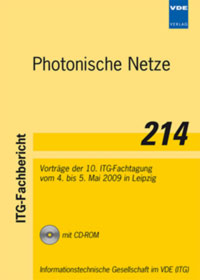Demonstration of an InP-based Electrical 1:2 Demultiplexer in a 107 Gb/s OOK System
Conference: Photonische Netze - 10. ITG-Fachtagung
05/04/2009 - 05/05/2009 at Leipzig, Germany
Proceedings: Photonische Netze
Pages: 5Language: englishTyp: PDF
Personal VDE Members are entitled to a 10% discount on this title
Authors:
Schubert, C.; Ludwig, R.; Schmidt-Langhorst, C. (Fraunhofer Institute for Telecommunication, Heinrich-Hertz-Institut, Einsteinufer 37, 10587 Berlin)
Makon, R. E.; Driad, R. (Fraunhofer Institute for Applied Solid State Physics, Tullastr. 72, 79108 Freiburg)
Steffan, A. G. (u2t Photonics AG, Reuchlinstrasse 10/11, 10553 Berlin)
Abstract:
The development of transmission technology for 100 Gigabit/s Ethernet systems is an active field of research worldwide. The development is concentrating mainly on low-baud-rate systems (up to 50 Gbaud) in conjunction with higher-order modulation formats (e.g. QPSK). These systems have the benefit of high spectral efficiency and robustness against chromatic dispersion or PMD. On the other hand they require complex, less cost-efficient transmitter and receiver architectures. A possible alternative, in particular for short reach, are higher-baud-rate systems (100 Gbaud). These systems have a simpler transmitter and receiver architecture which could result in cost-efficient realizations. However, in order to realize these architectures, compact and integrated solutions for the key components (optical-toelectrical-, electrical-to-optical-conversion, electrical amplification and processing) are required. Within the European project HECTO, funded under FP6, such key components are developed, based on InP technology. The use of InP technology offers the potential advantage of higher speed, higher breakdown voltages and monolithic integration (e.g. demultiplexer, photodiode and amplifier) on a single chip. In this paper, we report on the application of an InP-based electrical 1:2 demultiplexer (DEMUX), developed within HECTO, in a 107 Gb/s (100 Gb/s + FEC overhead) OOK system. The receiver was based on pure electrical timedivision multiplexing. It comprised a high-bandwidth photodetector, also developed within HECTO, and the DEMUX. The transmitter used optical time division multiplexing (OTDM) techniques. Measurements of eye diagrams, bit-error rates for 53.5 and 107 Gbit/s back-to-back, as well as investigations on the tolerance of the DEMUX to decision time and threshold (V-curves) are presented.


